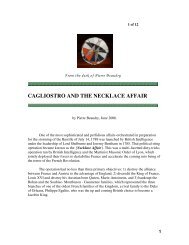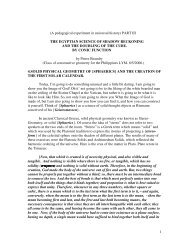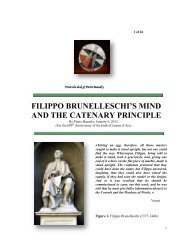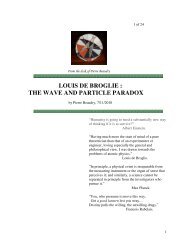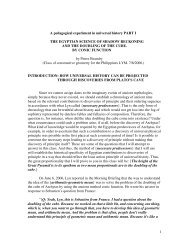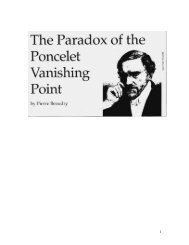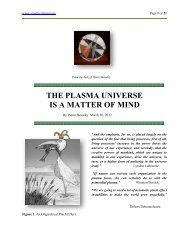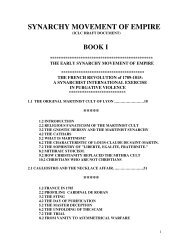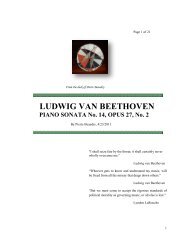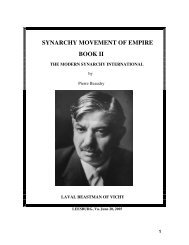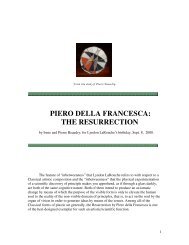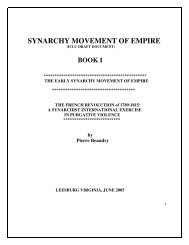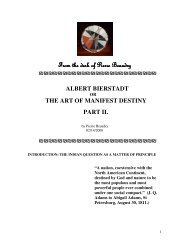BEETHOOVEN SONATA.pdf - Pierre Beaudry's Galactic Parking Lot
BEETHOOVEN SONATA.pdf - Pierre Beaudry's Galactic Parking Lot
BEETHOOVEN SONATA.pdf - Pierre Beaudry's Galactic Parking Lot
Create successful ePaper yourself
Turn your PDF publications into a flip-book with our unique Google optimized e-Paper software.
Page 1 of 11<br />
From the desk of <strong>Pierre</strong> Beaudry<br />
LUDWIG VAN BEETHOVEN<br />
PIANO <strong>SONATA</strong> QUASI UNA FANTASIA, OPUS 27 No. 2<br />
By <strong>Pierre</strong> Beaudry, 4/8/2011<br />
“The tension between something that is unattainable and<br />
the yearning for its mastery is the nature of the irony that<br />
every poet hates and cherishes at the same time; because,<br />
being on an ocean without a shore and constantly<br />
subjected to their ebbs and flows, the poet is forced to<br />
steer his course by the higher principle of the stars.”<br />
Dehors Debonneheure<br />
“Let the Lydian intervals be the wines that fill the cup of<br />
your soul.”<br />
Dehors Debonneheure<br />
1
1. THE BEETHOVEN PRINCIPLE OF AGAPE.<br />
Throughout history, poets, musicians, and artists alike have related to one another’s works in such<br />
great proportions that when they recalled one another’s kindred spirit of creative processes, the<br />
motivfuhrung of their artistic compositions, informed by the anti-entropic principle of agape, was<br />
capable of nourishing the creative flows of mankind for years to come. In our times, this is no longer the<br />
case, and it is crucial that we understand why. For example, this is how Francois Rabelais’ Panurge<br />
recalled the Platonic and Pythagorean Tetradic Steps of courage during his visit to Lanternland, in the<br />
same proportion that the first movement of Beethoven’s Sonata quasi una Fantasia No. 14, Opus 27, no.<br />
2 was an echo of Mozart’s Don Giovanni.<br />
When Andras Schiff gave his series of master classes on Beethoven’s 32 sonatas, he<br />
demonstrated how this 1801 Sonata in C Sharp Minor was the most misunderstood of all of Beethoven’s<br />
sonatas. There is like a “thick layer of false tradition on it, …” he said, “and the music is like a great<br />
painting that has a lot of dust on it, and a lot of dirt, and you want to restore it, so you can get to the real<br />
colors.”<br />
Indeed, in 1936, it was the foolish critic, Ludwig Rellstab who gave the nonsensical identification<br />
of “Moonlight Sonata” to this composition, when he compared it to his own fantasy on Lake Lucerne. On<br />
the contrary, what characterizes this sonata is the sublime love of creativity, as opposed to romantic<br />
pleasure and pain. It is the Promethean victory of agape over eros that one must look for in this<br />
Beethoven composition. Moreover, it is not an accident that Beethoven’s The Creatures of Prometheus<br />
was written during the same year.<br />
Beethoven left several notes in his manuscripts establishing his intention. According to these<br />
notes, Beethoven composed the first movement of his sonata as a funeral memorial to Mozart’s Don<br />
Giovanni. The notes refer to the specific section right after Don Giovanni stabbed the Commendatore to<br />
death. Not only does the sonata replicate the same ostinato triplets that Mozart used to express the dying<br />
moments of the Commendatore, but the same passages are rendered in C Sharp Minor. This homage was,<br />
as I will now show, Beethoven’s way of thanking Mozart for his own great Lydian revolution.<br />
At the opening measures of the first movement, Beethoven noted: “Adagio sostenuto. Si deve<br />
suonare tutto questo pezzo delicatessimamente e senza sordini” (Slow and sustained. One must play this<br />
whole movement with great delicacy and without dampers), that is to say, with sustained pedals on<br />
modern pianos, in order to maintain a continuous flow of the musical ideas. Furthermore, if this<br />
movement is to be understood as a motivfuhrung expression of the sublime, then, it cannot be played<br />
extra-slow like it is usually played. The point is that the piano must express the dynamic tension between<br />
the fear of individual death and the yearning for the immortality of mankind. Here is Beethoven’s<br />
opening measures and the Mozart section of Don Giovanni that he derived his musical idea from. (See<br />
Figure 1 and Figure 2)<br />
2
Figure 1. Beethoven Sonata quasi una fantasia, Opus 27, No. 2. Opening measures.<br />
Figure 2. Mozart’s Don Giovanni. Measures 186-189 mark the ostinato triplet palpitations of the<br />
Commendatore after he has been wounded mortally by Don Giovanni. Note the singing phrase of the<br />
Commendatore: “sento l’anima partir…” (I feel my soul leaving…) and, simultaneously, Leporello<br />
singing: “palpitar il cor mi sento.” (I feel his heart palpitating), and Don Giovanni who sings:<br />
“palpitante veggo l’anima partir” (through the palpitations, I see his soul leaving.) Thus, the perfect<br />
confusion of three different sense-perceptions.<br />
However, such an elementary musical idea as an ostinato triplet palpitation is very difficult to<br />
play properly on the keyboard, because it must also express, in substance, the Lydian principle of its<br />
ordering. In other words, the last heartbeats of a dying man, must also express the continuous process of<br />
3
change through which ideas are generated. During those dying moments, the Commendatore sings:<br />
“Now the pains of death invade me. From my breast my soul is soaring to eternal night or day…” The<br />
note is explicit about the transposition of the Mozart ostinato triplets in C sharp Minor referring to the<br />
heart palpitation of the dying Commendatore, but also expressing the palpitating idea of a fluid axiomatic<br />
change in musical ideas about the very form of the sonata.<br />
Beethoven noted in his manuscript:<br />
Once this relationship to Mozart is understood, you can no longer make the case of a romantic<br />
moonlit ride on Lac Lucerne.<br />
Here, Mozart played on the sensitive ambiguity between the pulse of the body and the pulsating<br />
of the musical triplet idea. The point is not simply the internalization of the heart throbs of the dying man,<br />
but also the fact that he is singing the swan song to his own body. He is telling his body that his soul is<br />
getting ready to leave it behind and soar into immortality. There is a crucial change, here, that Beethoven<br />
is stressing with emphasis, and that can only be expressed as the delicate flow of the motion of a<br />
singularity passing from life into death, and then, into immortality, delicatessimamente, as in a phase<br />
change relationship which must take place between two axiomatically different moments. The flow,<br />
however, must be expressed as an extended continuity of change, without percussiveness, and in a way<br />
where the continuum of change reflects causality Adagio sostenuto. That is the idea that Beethoven<br />
developed throughout the first movement of his sonata and which is extremely difficult to replicate.<br />
Like Schiff said, the whole first movement is strange because it is a funeral theme where all of<br />
the intervals strengthen one another in such a manner that all percussive relationships are excluded and no<br />
breaks must be sensed within the entire movement between the elements and the process that cause the<br />
element to change: the discontinuity must be continuous, as in the Leibnizian principle. In other words,<br />
this Sonata is not like any other Sonata. It is a musical revolution in the sense that its method of<br />
composition pertains to universal physical principles. The movement is not a sonata movement, as such,<br />
but an introduction to something that is completely new, a sort of introductory prelude to the other two<br />
movements. As Schiff put it, dynamically, everything must be “played pianissimo (very softly), almost<br />
like a Bach Prelude!” Remember how Gounod’s Ave Maria had transformed Bach’s first Prelude into a<br />
funeral memorial, for his deceased friends, Felix and Fanny Mendelssohn, that is the idea, but without<br />
emphasizing the effect of the discontinuity that Gounod introduced. Only the Lydian tension must be<br />
maintained throughout, and then released at the appropriate moment.<br />
2. THE LYDIAN MEASURES OF CHANGE.<br />
4
The very first measures of the sonata give the tone of the entire movement as a lamentation with a<br />
repetitive quadruple series of triplets which define the ostinato (obstinate) character of the emotion of a<br />
funeral march which is ironically as rapid and as steady as a beating heart. This is an almost exact replica<br />
of how Mozart wrote the score for the dying moments of the Commendatore. (See measures 186-89 in<br />
Figure 1.) The entire movement is unique in the sense that the same idea is repeated persistently in the<br />
same musical voice. The triplet intervals are intentionally written not to express the same weight and the<br />
same tension and to vary in their repetitions until they reach a point where the tension of the whole<br />
process is changed by inversion, releasing explicitly the Lydian principle that had been generating its<br />
entire dynamics from the beginning. (Measures … This middle section of ascending and descending<br />
series of Lydian clusters (that people identify wrongly as being merely diminished sevenths) are actually<br />
the resolution of the whole process. These clusters also need to be played as triplets, but as actual<br />
conscious generative inversions of the entire movement. It is because most musicians do not understand<br />
this Lydian agapic mood of Beethoven that they play this movement much too slow, and therefore, they<br />
miss the motivfuhrung unity of effect of this principle of composition.<br />
From the first movement to the third movement, the same triplets are interlaced as to confront the<br />
listener with two very strongly opposing emotions, one very soft and the other very tempestuous, both of<br />
which are intertwined with the same musical material. The same three note motif of the opening first<br />
movement, for example, notably C#, Ab, C#, and E, is reintroduced at the beginning of the third<br />
movement, in an expanded rhythmic development, which Beethoven marked as presto agitato, as if to<br />
emphasize the point that a funeral march can be transformed into a fiery Promethean force of change<br />
which is what this sonata that has succeeded in accomplishing. Of course, that idea was already in<br />
Beethoven’s mind even before he played the first triplet of the first movement.<br />
5
Figure 2. Beethoven Sonata quasi una fantasia, Opus 27, No. 2. The series of Lydian clusters<br />
underlying the ostinato triplet palpitations from the beginning.<br />
This is where the lack of melody turns to counterpoint. I cannot emphasize enough the<br />
importance of Bach, Mozart, and Haydn’s discovery of the Lydian clusters of minor thirds as the most<br />
revolutionary aspect of counterpoint during the eighteenth century. This is what will make Beethoven<br />
most happy at that period of his life when he realized he was going to become permanently deaf. As he<br />
wrote to his dearest friend Amanda on July 1, 1801: “A sad resignation must be my refuge, although,<br />
Indeed, I am resolved to rise above every obstacle.” This, without a doubt was the time when Beethoven<br />
had no choice but to settle his account with the domain of sense perception and consecrate the rest of his<br />
live to the domain of Classical artistic composition. However painful it must have been for Beethoven to<br />
accept his infirmity, his resignation before the fact that he would not become a virtuoso, or a famous<br />
conductor might have been a God sent gift to humanity. This is what led Thayer to raise the terrible<br />
question in his Biography: “Who can say that the world has not been a gainer by the misfortune which<br />
stirred the profoundest depths of his being and compelled the concentration of all his powers into one<br />
direction?” (Thayer’s Life of BEETHOVEN, revised and edited by Elliot Forbes, Princeton University<br />
Press, Princeton New Jersey, 1973, p. 282.)<br />
6
These are the historically specific conditions under which it can be said with a fair amount of<br />
certainty that during the short period of 1800-01, Beethoven made one of the greatest breakthroughs in<br />
Classical artistic composition with the Sonata quasi una fantasia. As he wrote to Amanda: “What is<br />
there that I might not accomplish? Since you left, I have composed everything except opera and church<br />
music.” (Beethoven letter to Amanda, July 1, 1801 in Op. Cit, p. 282.)<br />
I was reminded recently about Lyn’s piece on Truth is Beauty, and Beauty is Truth:<br />
Understanding the Science of Music, September 1986?… and the double-connectedness of the musical<br />
scale that Lyn referenced in that piece with respect to the science of music, especially to Abelian<br />
functions. (Quote from Lyn on Truth is Beauty…)<br />
The way to look at those Lydian clusters of minor thirds is to look at them as Plato looked at<br />
generating mean proportionality in his Timaeus; that is to say, in a manner such that one cannot be<br />
generated without generating another; the first creating a second that generates the third which, in turn<br />
produces the first. Thus, all three clusters are so intertwined into each other that they are all means of one<br />
another, and, therefore, they are all come to be one.<br />
THE WHITE OWL EFFECT OR THE SCIENCE OF EARLY WARNING<br />
SIGNALS OF PSYCHOPHYSICAL CORRELATIONS.<br />
Now, how does an axiomatic singularity occur in the mind? Think of how a new idea emerges<br />
suddenly as something that did not exist before. In fact, it had the potential to exist, but it did not exist in<br />
any given form. The question is, therefore, how does the form of a new idea take shape? The hypothesis<br />
that I will propose to you corresponds to what Lyn used to call the White Owl effect. Think of this effect<br />
as a metaphor for generating new ideas, that is, as a signal of what does not yet exist but is about to come<br />
in the near future. This is an effect that is of the domain of Riemannian and Abelian functions, in a playful<br />
way, which is not mathematical, but which announces the coming into being of all sorts of wave<br />
phenomena.<br />
Here, I want you to concentrate on the emergence of an axiomatic singularity that takes place<br />
inside of a torus. The best pedagogical device I have found to express that connection can be viewed as a<br />
dissonance that produces a tension inside of the relationship between the poloidal and the toroidal waves<br />
of a doubly connected process such as the steam rings of Mount Etna.<br />
7
Figure 3 The White Owl effect coming out of the steaming crater of the Mount Etna, Italy, 2007.<br />
Back in the 1970’s, Lyn used the example of the White Owl effect to describe the process of<br />
formation of the planetary orbits inside of a solar system, a process that was announcing the formation of<br />
solid planets orbiting around the Sun. Such an early warning system can be applied to almost any<br />
apprehensive phenomenon in the universe. Let me show you how the principle can be applied in the three<br />
cases of the Lithosphere, the Biosphere, and the Noosphere.<br />
The steam rings of Mount Etna (vapor and sulfuric dioxide) are warning signs that the volcano is<br />
about to erupt. They are produced by pressured gas and generated through shock waves through a narrow<br />
cylindrical conduit of the crater. Some of those rings last up to 10 minutes and appear to be formed within<br />
mushroom clouds generating poloidal steam rings around the main toroidal ring. Their most interesting<br />
behavior is that, after they have gone through an initial shock wave, they produce a series of contractions<br />
between two forms of circular action, the toroidal and poloidal motions of double connectedness. Such<br />
vortex ring phenomena are rarely understood as reflecting the complexity of generating ideas, but they do.<br />
8
Figure 4. Shock wave effect generating vortex flow. Professor of Fluid Dynamics, T. T. Lim, University<br />
of Melbourne, Australia.<br />
Moreover, Dolphins are also known to blow hollow bubble rings underwater just for fun, in<br />
anticipation of jumping through real hoops, as they often do. So you see, if dolphins can generate playful<br />
anticipatory ideas, like volcanoes do, and glide through them playfully, so can you. The point to be made,<br />
however, is to properly understand this conception of double-connectedness of rotary action. As you look<br />
into your own mind to study the phenomenon, think of an idea that you want to create that did not exist<br />
before, and willfully establish that such an idea is necessary for humanity. This implies the interaction of<br />
two different motions, one is the orbiting field of the history of ideas, and the other is the emergence of a<br />
new idea within that field. The congruence between those to motions is what you want to concentrate on.<br />
Then, before it gets to be completely formed, evaluate the content of this new idea by going all<br />
around the historical memory of mankind as if you were testing its value through the lens of a new<br />
discovery of principle that you have recently made. You will discover, as you go along, that other ideas<br />
you had formed in the past either reject the new idea or have been changed, dramatically, by this new idea<br />
as it comes into contact with them through the toroidal wave that carries each one of them, from the back<br />
to the front of your mind. That is the form of change that you want to think about as the result of the<br />
double-connectedness of your own mental process.<br />
Since a compression shock induces a wave motion in the same direction as the motion of the<br />
flow, the wave dynamics of the whole process is propagating in different ways throughout the whole<br />
process. Because the pressure inside of the tube is different than the atmospheric pressure outside of the<br />
tube. The wave which then comes out of the nozzle is initially a Prandtl-Meyer expansion flow, then, the<br />
wave system changes into a circular helix as it hits the shock front of the cooler atmosphere. That is<br />
precisely what happens when you have a hot idea to develop, and nobody wants to listen to you.<br />
9
CHANGE IS THE BEETHOVEN LYDIAN AGAPIC MODD<br />
People have a wrong sense of what change is, because they think of change as movement. That is<br />
the wrong way to look at change. You don’t look at change as the motion of a planet going around the<br />
Sun, or something that goes from one place to another. No, what change means is transformation,<br />
axiomatic transformation of something which goes into something completely different. That is to say,<br />
creative change in which your identity has been modified completely to the point you are no longer<br />
recognizable; a change in which your old friends say: “that’s not him.” When this happens to an entire<br />
society, such an axiomatic change implies that you no longer recognize the former laws that governed<br />
society; or you recognize that they are no longer valid. The change is such that nothing is the same<br />
anymore. That’s what change is about, ontologically speaking, and that is the source of every other form<br />
of change or movement. That is the form of change that Beethoven was introducing with the Sonata<br />
quasi una Fantasia.<br />
You can only begin to understand this more profoundly when you think of music in terms of what<br />
Lyn identified as “an interval of intervals,” and where the musical interval of intervals is the primary<br />
source of anti-entropic change. In an interview that he gave from Jail to Phil Rubinstein and Khushro<br />
Ghandi, in November of 1993, Lyn reported:<br />
“You have to see that causality is determined by this type of change. This type of change<br />
is ontologically primary. Now, for example in music, which a lot of people are having good fun<br />
with, now at least in the music work on conceptualizing the interval between intervals, where the<br />
interval is considered the primary sensory phenomenon – the interval as located in the domain –<br />
in its analysis situs – upward and downward. So, it’s not a physical interval because upward and<br />
downward are two different intervals, even though they are the same distance, so to speak, they<br />
have different intervals. So, the interval between intervals which takes you completely above the<br />
sensory domain – forget the overtones have nothing to do with music, as such, they are simply an<br />
imperfection of music, if you focus on them and try to work with them. So, this type of change –<br />
and as I’ve stressed – there’s another aspect to this, if we can map, using this interval between<br />
intervals, as a root of counterpoint, and we can map the motivfuhrung elaboration, implicitly. The<br />
best way to map is to take a number of major compositions, which are motivfuhrung compositions<br />
and map those, and do it for a number of different kinds of compositions, and now you’ve got a<br />
sense of what it is to map a composition from the motivfuhrung standpoint. And you’ll see those<br />
that do and don’t map.” (Lyndon LaRouche, DOCS: [61] 93393PR_001.DOC-<br />
INTERVIEW_WITH-LHL_PHIL_KHUSRO;1)<br />
10
This is what changing the past from the future is about. What Lyn identified as the Beethoven<br />
motivfuhrung, the underlying unity of composition as the epistemological interval. , as opposed to the<br />
physical intervals that Beethoven’s Sonata quasi Una Fantasia represents with respect to Mozart’s Don<br />
Giovanni. The ostinato triplets, for example are all similar physical intervals, ordered by the modality of<br />
the Lydian minor third clusters, but the constant equivalence that is going on between the mind of<br />
Beethoven and the mind of Mozart is the true interval of change, or measure of change between them,<br />
which corresponds to the Heraclites principle of “everything changes except change. That is the constant<br />
difference that binds Beethoven and Mozart together. This is the contrapuntal memory to be use rather<br />
than the rooting memory for the purpose of composition.<br />
Death is not death; it is an axiomatic change into a new beginning, a rebirth. This is why it is<br />
important to understand that what Mozart is referring to with the triplets is not the palpitation of the heart<br />
of a dying man, it is the rhythmic idea of how the same changes all the time in a regular and lawful way.<br />
Compare this unity of effect, this motivfuhrung with the last stanza of Ode to the West Wind by Percy<br />
Bysshe Shelley:<br />
“Make me thy lyre, even as the forest is:<br />
What if my leaves are falling like its own!<br />
The tumult of thy mighty harmonies<br />
Will take from both a deep, autumnal tone,<br />
Sweet though in sadness. Be thou, Spirit fierce,<br />
My spirit! Be thou me, impetuous one!<br />
Drive my dead thoughts over the universe<br />
Like withered leaves to quicken a new birth!<br />
And, by the incantation of this verse,<br />
Scatter, as from an unextinguished hearth<br />
Ashes and sparks, my words among mankind!<br />
Be through my lips to unawakened earth<br />
The trumpet of a prophecy! O, Wind,<br />
If Winter comes, can Spring be far behind?” (P. B. Shelley, Ode to the West Wind.)<br />
This is how death can be transcended, that is, changed into immortality. But how is it<br />
done? How do you transcend the tragic to go into the sublime? This is not a technical question,<br />
although there are technical means of doing it. The question is a moral question. It is the agapic<br />
commitment to improve mankind through the creative process of irony. So, for a moment, we are<br />
have elevated above our mortal coil when the poet gives us a taste in his mastery of overcoming<br />
death, with his reflection of the universal immortality of humanity. Now, that is when you get a<br />
sense of this process of change as a process of causality.<br />
So, how does Beethoven perform such a change in the Sonata quasi una fantasia?<br />
11




